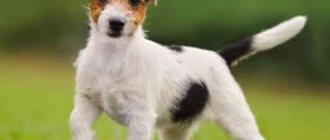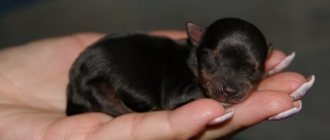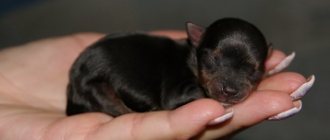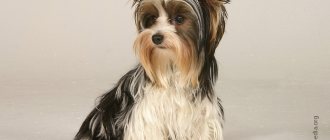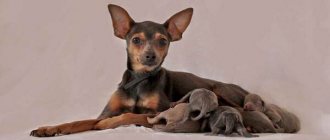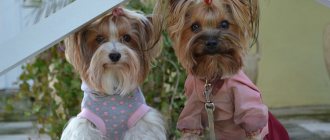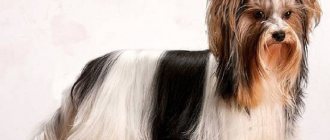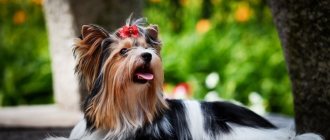Yorkshire terriers are decorative dogs with a lot of positive qualities, thanks to which they have become so popular all over the world.
Yorkies require special care, and this requirement applies not only to adult dogs, but also to puppies.
It is important to understand how the normal development of puppies should proceed, what the weight of the babies should be and when they should be vaccinated, because all these factors are the key to good health and longevity of the dog.
This and much more will be discussed in the article - you will learn how Yorkie puppies develop, how many months they grow and what they need to grow into healthy dogs.. Also here you will find photos with puppies of different ages.
What do newborn Yorkies look like?
Newborn Yorkshire Terrier puppies are born with a smooth black coat and red tan. Their appearance resembles miniature Rottweilers.
A newborn Yorkie has no teeth and his eyes and ears are closed, which means he does not see or hear anything and is guided only by smell.
IMPORTANT!
They have virtually no thermoregulation, so it is necessary to monitor the air temperature - both hypothermia and overheating are detrimental for puppies.
The size and weight of the puppies depends on whether they are standard or mini Yorkshire Terriers. On average, at birth, puppies weigh from 80 to 160 grams.
Origin story
The Yorkie was not always a lap dog. At the dawn of the breed's history, these dogs, bred in Yorkshire, were working terriers: they destroyed rodents in houses and in mines.
Only later did they become a salon breed, and their popularization was greatly facilitated by the fact that Yorkshires were the favorites of Queen Victoria, during whose reign the breed was officially recognized.
At the beginning of the 20th century, the number of Yorkies was still small, but it was from this time that their spread throughout the world began..
The 1940s did not have the best effect on the breed, since during the Second World War people had no time for breeding dogs that had no practical value for the front.
But after its end, the number of Yorkies began to increase again, and the popularity of the breed began to revive.
By now, Yorkshire dogs are loved in many countries, including Russia . We can say that this is one of the most famous small dog breeds in the modern world.
Growth and development
2-3 days after birth, puppies begin to crawl. At 10-15 days their eyes open, the puppies begin to respond to light, but the retina is still poorly developed.
By 18-21 days, Yorkie babies develop a fat layer, thermoregulation appears, and they begin to respond to sharp sounds.
On days 20-24, teeth begin to erupt, and by this age the puppy begins to hear.
By the month the puppies' activity increases, they leave their “playpen” and get acquainted with their surroundings.
At 8-9 months, the change of teeth ends, and the dog begins puberty. By this age, the Yorkshire Terrier reaches its maximum height, but is still developing.
In the first months of life, puppies develop as intensively as possible; it is important to monitor weight gain in order to understand that the puppy is eating correctly and is not underweight or overweight.
Yorkie puppies weight table by month:
| Age | Micro | Mini | Standard |
| Birth weight | 80 gr | 115 gr | 160 gr |
| 1 month | 230 gr | 370 gr | 595 g |
| 2 months | 370 gr | 610 gr | 940 gr |
| 3 months | 540 gr | 850 gr | 1280 gr |
| 4 months | 710 gr | 1110 gr | 1680 g |
| 5 months | 850 gr | 1300 gr | 1990 gr |
| 6 months | 940 gr | 1450 gr | 2210 gr |
| 18 months | 1140 gr | 1820 gr | 2730 gr |
As adults, standard Yorkshire terriers reach a height at the withers of 22-24 cm, mini - 16-18 cm, micro - up to 15 cm.
Yorkshire Terrier - description of the breed
The Yorkshire Terrier is one of the smallest dogs, their weight should not exceed 3.2 kg. Externally, it is distinguished by long hair, which should fall completely straight down the sides of the body. A healthy dog normally has not only compact size, but also graceful posture. The Yorkie's body should be strong and athletic, especially if the animal has systematic physical activity. Yorkshire terriers today are bred for decorative purposes; over many years of crossing, they have practically lost their hunting instincts, but they have retained the energy and curiosity inherent in the entire group.
Standard
Dog training standards were adopted in 1954 and have remained virtually unchanged to date. According to accepted rules, the size of a dog is limited only by the upper limit; there are no minimum requirements for weight and height. Basic criteria for assessing this breed:
Frame:
- The Yorkshire Terrier's body is very compact; its height should not exceed 20 cm.
- The loin is strong and developed, with convex ribs on the chest.
- The maximum weight is 3.2 kg; too small or large representatives are a defect, despite the popularity of Yorkshire terriers of non-standard size.
Head:
- The skull is small and flat, no convexity or visible roundness is allowed.
- The tip of the nose is black, the jaws should have a regular scissor bite.
- The eyes are medium in size, dark and have an intelligent expression.
- The ears are small and should be in a V-shaped position; lop-eared individuals are discarded.
- The length of the muzzle is 1/3 of the head; the ears are set high and should not appear protruding.
Limbs:
- The front legs should be straight and have well-developed hair.
- The ends of the hair have a lighter shade than the roots; red-brown color above the elbows is not allowed.
- The hind legs are visually located at a right angle, and are also covered with a large layer of hair.
- The paws are rounded, the claws are black.
Tail:
- It is small in size and has well-developed fur on all surfaces.
- According to the old standard, it had to be docked; today this procedure is prohibited in all European countries.
Wool:
- The Yorkshire Terrier is a long-haired breed with no undercoat.
- Its structure resembles human hair and practically does not fall out.
- On the body, the coat should be completely straight, shiny and silky.
- The greatest length is on the sides of the body and head.
- According to the standard, the coat should have a golden-brown-gray color; in some parts of the body, silver, black and blue shades are allowed.
- Bald individuals and dogs with excessively curly hair are not allowed.
Yorkshire terriers are displayed on the table - this allows you to evaluate the animal’s body and identify the presence of breed defects. If you plan to participate in competitions, then your Yorkie requires careful care and regular physical activity - this allows you to maintain an athletic body shape.
Colors
According to the accepted standard, the Yorkshire Terrier must have a two-tone color - a combination of grayish-blue and reddish-brown shades. At the same time, on the head and neck there is a more saturated color, and on the chest and lower parts of the limbs a reddish-ashy tint is possible.
Many varieties of the breed have been developed, differing in coat color. However, not all of them are accepted by the standard and are allowed to participate in exhibitions. For example, marbled, monochrome black and white Yorkshire terriers, chocolate and completely red ones were bred.
Types of puppies
A litter born from two standard representatives of the breed may produce standard puppies or the so-called mini, super-mini and baby-face Yorkies, which differ from the standard ones in weight and have a shorter muzzle with an upturned nose.
Also, puppies can belong to such varieties of Yorkshire terriers as Russian Saloon, Goldust, Chocolate or Biro, but this can only happen as a result of targeted breeding work .
Vices of non-standard dogs
Representatives of the breed that do not meet the standard have a lot of health problems. So, in Yorkies that are too light, the following are most often observed:
- Hypoglycemia.
- Drowsiness, lethargy, lack of coordination of movements caused by hypoglycemic shock.
- Digestive problems.
- Periodontal disease.
- High probability of fractures.
- Joint diseases.
- Dislocation of the kneecap.
- Tracheal collapse.
- Otitis.
- Cryptorchidism.
- Non-overgrowing fontanel.
- Legg-Calvé-Perthes syndrome.
- Intolerance to anesthesia.
Also, female mini or micro Yorkies are not allowed to breed - they cannot bear and give birth to healthy puppies on their own. To get small puppies, standard females are mated with small males. The structural features of the Baby Face Yorkie's muzzle are the cause of chronic conjunctivitis (due to a narrow tear duct and frequent eye injuries) and breathing problems, which is why the dog can “grunt” while moving and snore.
The life expectancy of non-standard representatives of the breed is much lower: 10 - 12 and 7 - 9 years for mini and super mini Yorkies, respectively.
How to care?
During the first weeks of life, the puppies are looked after by a bitch - she feeds them, turns them over, and constantly licks them. The breeder must only ensure that the puppies do not become hypothermic or overheated, and that the bitch does not accidentally crush them.
On the 3-5th day, they need to remove the dewclaws, if any - you need to stretch the skin on the puppy’s paw and quickly cut off the extra toe with sharp office scissors, and then cauterize the wound with potassium permanganate.
NOTE!
At this age, puppies do not yet react too much to pain and if the procedure is carried out correctly, they will not react to it in any way.
Around the 5th-6th day, you need to trim the nails so that they do not hurt each other or the belly and nipples of the bitch during feeding.
Puppies should not be bathed until they are 3 months old, but they must examine their eyes daily and wipe them with chamomile infusion or a special lotion.
At about a month, when the coat is quite long, the puppies need to have a hygienic haircut - use a special clipper to trim the hair in the groin area, near the genitals and anus. It is also necessary to free the upper third of the ears from fur so that they do not bend under its weight and acquire the vertical position required by the breed standard.
At the same age, you should begin raising puppies, accustoming them to a diaper or tray.
When the Yorkshire Terrier grows up and is vaccinated, he should be walked every day - this is necessary not only for the physical health of an active and energetic dog, but also for its socialization and the formation of a stable psyche.
After each walk, you need to thoroughly wash your paws and belly, and give your pet a full bath about once every 3 weeks.
You should also brush your dog daily to prevent its fur from getting tangled, and monitor the condition of its teeth, mouth, and ears.
Character
Mini Yorkshire Terriers have a soft, affectionate, good-natured character that allows them to easily get along with other pets. They are energetic, active and inquisitive, prefer to be constantly on the move and love walks. These are not aggressive dogs, however, if necessary, they will selflessly defend their owner and their territory.
Mini Yorkies get along well with children, but you should not buy this dog if the child is very small - if he is careless, he can harm the tiny, fragile dog. Small representatives of Yorkshire terriers are attached to the owner as strongly as standard Yorkies and do not tolerate loneliness well, experiencing almost physical suffering when left alone. At the same time, they are less intrusive.
Feeding the puppy
During the first weeks of life, the diet of Yorkshire Terrier puppies includes only mother's milk.
When the puppies are 3 weeks old, you should begin introducing complementary foods consisting of preheated milk, lean meat, cottage cheese or kefir, but not more than 2 tsp. in a day.
At the age of 2-3 months, low-fat sea fish, vegetables (beets, bell peppers, pumpkin), green apples, offal, and boiled cereals should be added to the puppy’s diet.
IMPORTANT!
All new foods must be introduced into the Yorkshire Terrier's diet gradually, carefully observing how the pet reacts to them.
Food for a puppy should be at room temperature or a little warmer and cut into small pieces, and if the pet is less than 3 months old, crushed to a puree.
If your puppy's diet consists of ready-made dry food, the brand should be designed specifically for Yorkshire Terrier puppies.
The diet can be free, but Yorkies are prone to overeating and obesity, so it is better to organize the diet depending on the age of the puppy:
- up to 2 months – 6 times a day;
- 2-3 months – 5 times;
- 4-5 months – 4 times;
- 6-12 months – 3 times.
A one-year-old dog needs to be fed 2 times a day - morning and evening.
The serving size is calculated based on the dog's weight - 1-2 tbsp. for every 500 grams of weight.
The puppy should always have access to clean water. It should be soft (settled or filtered); hard water can cause Yorkie urolithiasis.
Which haircut to choose depending on your coat type
- Fluffy: Yorkies with a furry coat look great with Korean haircuts. Thanks to its rounded shape and fluffiness, the pet becomes very similar to a toy.
- Coarse: Medium hair length is suitable for these animals. If you cut it short, the hairs will stick out and your Yorkie will look unkempt. And if the wool is long, it will not lie in even strands even after balm. Such a dog, again, will look untidy.
- Smooth, silky: Yorkies with this type of coat suit all haircuts. With this type of cover you can participate in exhibitions and conduct experiments.
An experienced groomer will help you choose the best option that will make your pet look attractive.
First vaccinations
Mother's milk protects newborn puppies from infections and diseases. When the feeding period ends, this protection disappears and is replaced by immunity developed by the puppies on their own.
Vaccinations are required to develop the immune system.
Any vaccination has several basic rules:
- It is prohibited to vaccinate a pregnant or lactating bitch;
- You should not vaccinate too early, otherwise it will not work and the risk of infection will increase;
- the same drug should be used for vaccination and revaccination;
- the puppy must be completely healthy.
CAREFULLY!
Vaccinating a sick or weakened pet after an illness can cause death.
In addition, 7-10 days before vaccination it is necessary to carry out deworming, and the dog cannot be bathed a day before the procedure.
The standard vaccination schedule includes vaccinations against rabies, hepatitis, parvovirus gastroenteritis, distemper and leptospirosis.
Vaccination schedule:
- 1st vaccination – 8-9 weeks;
- revaccination – 10-11 weeks;
- 3rd vaccination – after changing teeth, approximately 7.5-8 months;
- rabies vaccination – 3-4 months and a year.
In the future, the Yorkshire Terrier must be vaccinated annually at the same time.
The owner chooses the vaccine for vaccination himself (usually Eurikan or Nobivak), and notes on the vaccinations performed are made in the veterinary passport.
A slight increase in temperature and refusal to eat after vaccination is a normal reaction of the body.
Briefly about the main thing
- The Yorkshire Terrier is a decorative breed originally from England. It was originally bred to hunt rats.
- Yorkie weighing up to 3.2 kg. According to the standard, they have a well-built body, long hair, colored in a golden-brown-gray shade.
- Yorkies are active and inquisitive. They get along well with people and are companions.
- These dogs have many hereditary pathologies. You should carefully choose a puppy, giving preference to proven kennels.
Have you had any experience keeping a Yorkshire Terrier? Share your opinion about this breed in the comments.
How to bathe properly?
Before bathing your puppy in the bathtub or sink, you need to lay a rubberized mat so that the pet does not slip. You should use shampoo and conditioner that is appropriate for your coat type and will make it easier to comb, and the water should be at room temperature.
The shampoo should be rubbed in your palms, mixed with water, lathered on the dog and rinsed off, repeating all this twice. Then apply conditioner, leave it on the coat for 2-3 minutes and rinse.
When bathing, you need to make sure that water does not get into your Yorkie's ears - it is better to cover them with cotton swabs.
After bathing, wrap your pet in a towel, then dry the coat with a hairdryer and comb it.
You can bathe the puppy only after a two-week quarantine has passed after the 2nd vaccination, i.e. at about three months of age.
Necessary preparation for childbirth
Giving birth to a Yorkie at home is not something scary if you prepare for it in advance. If difficulties or questions arise, it is recommended to consult a veterinarian.
The first and most important thing you need for childbirth is a place. It should be secluded and warm. You can use a special oilcloth as bedding. Also, a bowl of water and food must be placed next to this place.
Important! It is best to stock up on more disposable diapers. In the future, they will also be useful for postpartum care.
To process puppies you will need:
- pipette to remove mucus from the nose;
- sterile scissors to cut the umbilical cord;
- thread, cotton wool and brilliant green - for processing.
In addition, just in case, you should acquire the following medications:
- calcium gluconate;
- oxytocin;
- no-shpa;
- diphenhydramine;
- saline;
- alcohol;
- brilliant green;
- syringes.
The veterinarian will tell you in detail about their possible use. Owners who have never given birth are advised to consult with a specialist and clarify all questions of interest.
Important! Long hair will only get in the way during childbirth. Therefore, the dog should be trimmed in the belly and groin area. It will also be necessary to trim the animal's claws.
Shaving the belly
Changing and brushing teeth
The change of teeth from milk teeth to molars in Yorkies begins at 3.5-4 months and should be completely completed by 8-9 months, maximum by 1 year.
During this period, the puppy should be given toys that are easy to chew and special treats to help the teeth loosen faster.
IMPORTANT!
If a molar grows next to a missing baby tooth, or if a wound or swelling is found in the puppy’s mouth, you need to show your pet to a veterinarian.
Due to the special arrangement of teeth, food debris often accumulates between them, which needs to be cleaned out with a toothpick.
In addition, Yorkshire terriers are prone to plaque and the formation of stones, so you need to brush your pet’s teeth 2-3 times a week with a special paste and brush sold in pet stores, and conduct a thorough cleaning at the veterinary clinic twice a year.
Similar breeds
Decorative breeds have many common characteristics. The following are considered similar to Yorkshire Terriers:
Pomeranian Spitz
Shih Tzu
Chihuahua
Yorkshire terriers have a unique coat - it differs in length and structure. Like other terriers, they have slightly angular body features, with limbs at right angles. Unlike long-haired Chihuahuas, they have a larger weight and size, as well as color.
When is weaning from the mother?
You need to take into account the condition of the bitch and the behavior of the puppies - when the puppies are cutting teeth and growing claws, the bitch may experience unpleasant and painful sensations during feeding. This indicates that it is time to wean the puppies.
Most often, puppies are separated from their mother when they are 50-60 days old. Moreover, if the bitch has problems with lactation and there is not enough milk, this can be done at 3 weeks.
Choosing a nickname
Read: Nicknames for Yorkshire Terriers - choose the right one for your pet
The name for the dog should be chosen taking into account its character and behavior. The most popular nicknames for Yorkshire Terriers:
| Boys: | Butch, Black, Argus, Dar, Zhostik, Pencil, Knopik, Rich, Snoop, Tatoshka. |
| Girls: | Alma, Barbie, Denis, Julie, Lyalya, Mushka, Uma, Trisha, Oxy. |
The puppy should be accustomed to its name from the first days of its arrival in the house. This will simplify further contact with your dog and allow you to achieve full interaction.
How to choose a puppy?
First of all, you need to choose a trusted nursery and conscientious breeders - this will minimize the risk of buying an unhealthy puppy. In the kennel, you need to pay attention to the living conditions of the dogs, find out about the puppy’s parents and their health. The breeder must answer all questions and present all necessary documents.
A healthy puppy should be active, friendly and curious, be able to feed itself, and have:
- black, cold and wet nose;
- dark eyes, without discharge and increased lacrimation;
- the stomach is not bloated;
- the coat is soft, thick and shiny, without bald spots;
- skin without peeling, rashes or signs of irritation;
- each jaw has 2 canines and 6 incisors, scissor bite.
The puppy must also have a veterinary passport with deworming and vaccination records.
Owner reviews
Ksenia K.
“We have had a Yorkshire terrier in our family for 10 years. This is a very kind and understanding dog, there have never been any problems. We have already experienced several births, and strong and healthy puppies were always born.”
Victor A.
“My wife and I were looking for a small dog to keep in our apartment. We chose the Yorkie with caution, as they are now being bred a lot. As a result, they chose the male who was the most active among the others. It feels like a very smart and inquisitive dog, but there is a minus – it barks a lot at extraneous sounds.”
